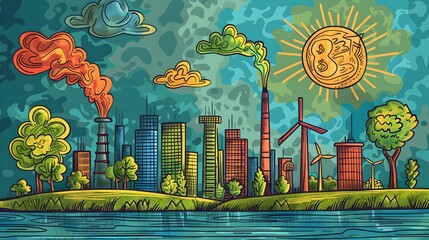Introduction to Climate Change
Climate change is one of the most pressing challenges facing humanity in the 21st century. It refers to long-term shifts in temperature, precipitation patterns, and other aspects of the Earth’s climate system, primarily caused by human activities such as burning fossil fuels, deforestation, and industrial processes.
Understanding Climate Change
Causes of Climate Change
The primary drivers of climate change include the emission of greenhouse gases (GHGs) such as carbon dioxide (CO2), methane (CH4), and nitrous oxide (N2O) into the atmosphere. These gases trap heat, leading to the warming of the planet—a phenomenon known as the greenhouse effect.
Effects of Climate Change
The impacts of climate change are far-reaching and include rising global temperatures, more frequent and severe weather events, melting ice caps and glaciers, sea-level rise, biodiversity loss, and disruptions to ecosystems and agriculture.

The Urgency of Climate Change Mitigation
The Need for Action
Given the dire consequences of unchecked climate change, there is an urgent need for mitigation efforts to reduce GHG emissions and limit global warming. Failure to act swiftly could lead to irreversible damage to the planet’s ecosystems and jeopardize the well-being of future generations.
Environmental Impact
Unchecked climate change poses a significant threat to biodiversity, with many species facing extinction due to habitat loss, shifting migration patterns, and increased risk of disease and predation.
Social and Economic Implications
Climate change exacerbates existing social and economic inequalities, disproportionately affecting vulnerable communities and exacerbating poverty, food insecurity, and displacement.

Overview of Climate Change Mitigation Technologies
What is Climate Change Mitigation?
Climate change mitigation refers to efforts aimed at reducing or preventing the emission of GHGs into the atmosphere, thereby slowing the rate of global warming and its associated impacts.
Definition and Goals
The primary goal of climate change mitigation is to stabilize the Earth’s climate by limiting global temperature rise to well below 2 degrees Celsius above pre-industrial levels, as outlined in the Paris Agreement.
Importance of Mitigation Technologies
Mitigation technologies play a crucial role in achieving climate targets by enabling the transition to low-carbon energy sources, improving energy efficiency, and promoting sustainable land use practices.
Renewable Energy Solutions
Harnessing Renewable Energy
Renewable energy sources such as solar, wind, hydroelectric, and geothermal power offer sustainable alternatives to fossil fuels, emitting little to no GHGs during operation.
Solar Power
Solar power involves converting sunlight into electricity using photovoltaic cells or solar thermal collectors, offering a clean and abundant source of energy.
Wind Energy
Wind energy harnesses the power of wind turbines to generate electricity, providing a scalable and cost-effective solution for reducing reliance on fossil fuels.
Carbon Capture and Storage (CCS)
Trapping Carbon Emissions
CCS technologies capture CO2 emissions from power plants and industrial facilities, transporting and storing them underground to prevent their release into the atmosphere.
How CCS Works
CCS involves three main steps: capturing CO2 from point sources, transporting it to storage sites via pipelines or ships, and injecting it deep underground into geological formations for long-term storage.
Applications and Challenges
CCS has the potential to significantly reduce emissions from large industrial sources such as power plants and cement factories, but widespread deployment faces technical, regulatory, and economic challenges.
Sustainable Agriculture Practices
Greening Food Production
Sustainable agriculture practices focus on reducing emissions from agricultural activities while promoting food security, soil health, and biodiversity conservation.
Regenerative Farming
Regenerative farming techniques such as no-till farming, crop rotation, and cover cropping improve soil carbon sequestration, water retention, and nutrient cycling, mitigating the environmental impact of agriculture.
Agroforestry
Agroforestry integrates trees and shrubs into agricultural landscapes, providing multiple benefits such as carbon sequestration, erosion control, and habitat for wildlife.

Green Buildings and Sustainable Infrastructure
Constructing for the Future
Green building practices emphasize energy efficiency, resource conservation, and indoor air quality, reducing the environmental footprint of residential, commercial, and institutional buildings.
Energy-Efficient Buildings
Energy-efficient buildings incorporate features such as insulation, high-performance windows, and efficient HVAC systems to minimize energy consumption and reduce GHG emissions.
Sustainable Transport
Sustainable transport solutions include electric vehicles, public transportation, cycling infrastructure, and urban planning designs that prioritize walking and cycling over car dependence, reducing emissions from the transportation sector.
Climate-Smart Forestry
Preserving Our Forests
Climate-smart forestry practices aim to conserve and sustainably manage forest ecosystems to enhance their resilience to climate change while maximizing carbon sequestration and biodiversity conservation.
Reforestation Efforts
Reforestation involves planting trees on degraded or deforested lands to restore forest cover, enhance carbon sequestration, and provide habitat for wildlife.
Forest Management Techniques
Forest management techniques such as sustainable logging, selective harvesting, and fire prevention help maintain healthy forests, reduce emissions from deforestation, and promote sustainable wood products.

Technological Innovations in Transportation
Driving Towards Sustainability
Technological innovations in transportation offer promising solutions for reducing emissions from the transportation sector and transitioning to low-carbon mobility options.
Electric Vehicles
Electric vehicles (EVs) powered by batteries or fuel cells offer a clean alternative to traditional gasoline and diesel vehicles, reducing air pollution and greenhouse gas emissions.
Public Transportation Solutions
Investments in public transportation infrastructure, including buses, trains, and light rail systems, promote mass transit as a sustainable and efficient mode of transportation, reducing traffic congestion and emissions.
Climate Resilience and Adaptation Measures
Adapting to a Changing Climate
Climate resilience and adaptation measures aim to prepare communities, ecosystems, and infrastructure for the impacts of climate change, reducing vulnerability and enhancing adaptive capacity.
Resilient Infrastructure
Building resilient infrastructure, such as seawalls, flood barriers, and green infrastructure, helps protect coastal communities from sea-level rise, storm surges, and flooding events.
Community Preparedness Programs
Community-based adaptation initiatives, including early warning systems, disaster risk reduction strategies, and community-led resilience projects, empower local communities to cope with climate-related hazards and emergencies.
International Collaboration and Policy Initiatives
Global Efforts for Change
International collaboration and policy initiatives play a crucial role in addressing climate change on a global scale, fostering cooperation among nations to reduce emissions and build resilience to climate impacts.
The Paris Agreement
The Paris Agreement, adopted in 2015, aims to limit global warming to well below 2 degrees Celsius above pre-industrial levels and pursue efforts to limit the temperature increase to 1.5 degrees Celsius, recognizing the urgent need for action to address climate change.
Kyoto Protocol
The Kyoto Protocol, an international treaty adopted in 1997, established binding emissions reduction targets for developed countries and introduced mechanisms for carbon trading and offsetting to incentivize emission reductions.

Challenges and Barriers to Implementation
Overcoming Obstacles
Despite growing awareness of the need for climate action, there are significant challenges and barriers to the implementation of mitigation and adaptation measures, including political, economic, technological, and social factors.
Political Will and Policy Challenges
Political resistance, competing interests, and policy inertia often hinder progress on climate change mitigation and adaptation at the national and international levels, delaying the implementation of effective solutions.
Economic Considerations
The transition to a low-carbon economy requires substantial investments in renewable energy, infrastructure upgrades, and sustainable practices, posing economic challenges for governments, businesses, and individuals.
The Role of Businesses and Industries
Corporate Responsibility
Businesses and industries have a critical role to play in addressing climate change through sustainable business practices, emissions reductions, and corporate social responsibility initiatives.
Sustainable Business Practices
Adopting sustainable business practices, such as energy efficiency measures, renewable energy procurement, and waste reduction strategies, can help companies reduce their environmental footprint and contribute to climate mitigation efforts.
Green Supply Chains
Promoting green supply chains involves sourcing materials and products from environmentally responsible suppliers, reducing emissions throughout the supply chain, and promoting transparency and accountability in business operations.
Public Awareness and Education Campaigns
Spreading the Message
Public awareness and education campaigns play a vital role in mobilizing action on climate change, raising awareness about the impacts of climate change, and empowering individuals to take meaningful steps to reduce their carbon footprint.
Environmental Education Programs
Integrating climate change education into school curricula, community outreach programs, and public awareness campaigns helps build knowledge and awareness about climate change science, impacts, and solutions.
Media and Communication Strategies
Effective media and communication strategies, including storytelling, visual imagery, and digital platforms, help engage diverse audiences and inspire collective action on climate change, fostering a sense of urgency and shared responsibility.

Conclusion
In conclusion, climate change mitigation technology offers promising solutions for building a sustainable future by reducing greenhouse gas emissions, enhancing resilience to climate impacts, and promoting sustainable development. However, addressing climate change requires collective action, political will, and international cooperation to overcome barriers and implement effective solutions. By harnessing the power of innovation, collaboration, and public engagement, we can transition to a low-carbon economy and create a more sustainable and resilient world for future generations.

FAQs (Frequently Asked Questions)
- What is climate change mitigation? Climate change mitigation refers to efforts to reduce or prevent the emission of greenhouse gases into the atmosphere, thereby slowing the rate of global warming and its associated impacts.
- How does renewable energy contribute to climate change mitigation? Renewable energy sources such as solar, wind, hydroelectric, and geothermal power emit minimal greenhouse gases during operation, offering a clean and sustainable alternative to fossil fuels.
- What are some examples of climate-smart forestry practices? Climate-smart forestry practices include reforestation, sustainable logging, selective harvesting, and agroforestry, which help conserve forest ecosystems, enhance carbon sequestration, and promote biodiversity conservation.
- How can businesses and industries contribute to climate change mitigation? Businesses and industries can reduce their environmental footprint by adopting sustainable practices, investing in renewable energy, promoting green supply chains, and engaging in corporate social responsibility initiatives.
- What role do public awareness and education campaigns play in addressing climate change? Public awareness and education campaigns raise awareness about the impacts of climate change, empower individuals to take action, and mobilize support for climate mitigation and adaptation efforts.





